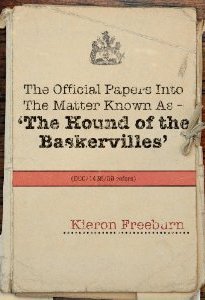The Official Papers Into The Matter Known As The Hound of the Baskervilles
Some time ago I reviewed a book which was sold on the basis that it provided you with facsimiles of documents that were pertinent to a number of Sherlock Holmes's cases. One of these cases was The Hound of the Baskervilles. The result was a very disappointing offering that was more akin to a monthly magazine collection than a serious Sherlockian work.
Consequently, when I was asked to cast my eye over The Official Papers Into The Matter Known As The Hound of the Baskervilles I very much feared more of the same. Fortunately my fears were largely unfounded. The author Mr Freeburn has mined the original story and other tomes on the subject and used this information and his experience as a former CID officer to produce a series of authentic looking papers.
What you get are police reports, witness statements, coroners' reports, post-mortem findings and correspondence between various police figures that were supposedly involved in the events of the novel even if that involvement was out of the book's scope.
One of the most enjoyable aspects is the exchange of correspondence between figures in the Devon constabulary and Scotland Yard over what they see as an unwarranted breech of protocol in Holmes summoning a Scotland Yard Inspector (Lestrade) to Devon rather than making use of the local force. One can easily imagine such events taking place behind the scenes and it helps give the story some valuable background even if it did not come from the pen of Conan Doyle himself.
However there are downsides. As has been pointed out in other reviews, the forename of the convict Selden changes and there is the odd spelling mistake. In one of the facsimile newspapers your attention is drawn to the spelling mistakes which are underlined. This is presumably because they were being identified by the software that was used to create them. There are other mistakes which could have been easily ironed out if the book had been put before another Sherlockian in advance of publication.
The other downside is the chosen font which the author recognises as an issue and warns you about. The vast majority of the book is written in a sloping font designed to mimic handwriting. Whilst it adds authenticity it makes the book very hard to read and, in my case, I had to regularly stop in order to avoid a headache. In hindsight I think it would have been better to have put some (or all) of the "handwritten" documents into an appendix and present more readable versions in the front. Then again this would no doubt have made the book more expensive.
In summary, this is a good book that largely achieves what it sets out to do. It is slightly let down by some relatively minor mistakes and an eye-straining font but undeniably adds another dimension to one of Sherlock Holmes's greatest cases.
Consequently, when I was asked to cast my eye over The Official Papers Into The Matter Known As The Hound of the Baskervilles I very much feared more of the same. Fortunately my fears were largely unfounded. The author Mr Freeburn has mined the original story and other tomes on the subject and used this information and his experience as a former CID officer to produce a series of authentic looking papers.
What you get are police reports, witness statements, coroners' reports, post-mortem findings and correspondence between various police figures that were supposedly involved in the events of the novel even if that involvement was out of the book's scope.
One of the most enjoyable aspects is the exchange of correspondence between figures in the Devon constabulary and Scotland Yard over what they see as an unwarranted breech of protocol in Holmes summoning a Scotland Yard Inspector (Lestrade) to Devon rather than making use of the local force. One can easily imagine such events taking place behind the scenes and it helps give the story some valuable background even if it did not come from the pen of Conan Doyle himself.
However there are downsides. As has been pointed out in other reviews, the forename of the convict Selden changes and there is the odd spelling mistake. In one of the facsimile newspapers your attention is drawn to the spelling mistakes which are underlined. This is presumably because they were being identified by the software that was used to create them. There are other mistakes which could have been easily ironed out if the book had been put before another Sherlockian in advance of publication.
The other downside is the chosen font which the author recognises as an issue and warns you about. The vast majority of the book is written in a sloping font designed to mimic handwriting. Whilst it adds authenticity it makes the book very hard to read and, in my case, I had to regularly stop in order to avoid a headache. In hindsight I think it would have been better to have put some (or all) of the "handwritten" documents into an appendix and present more readable versions in the front. Then again this would no doubt have made the book more expensive.
In summary, this is a good book that largely achieves what it sets out to do. It is slightly let down by some relatively minor mistakes and an eye-straining font but undeniably adds another dimension to one of Sherlock Holmes's greatest cases.



Comments
Post a Comment